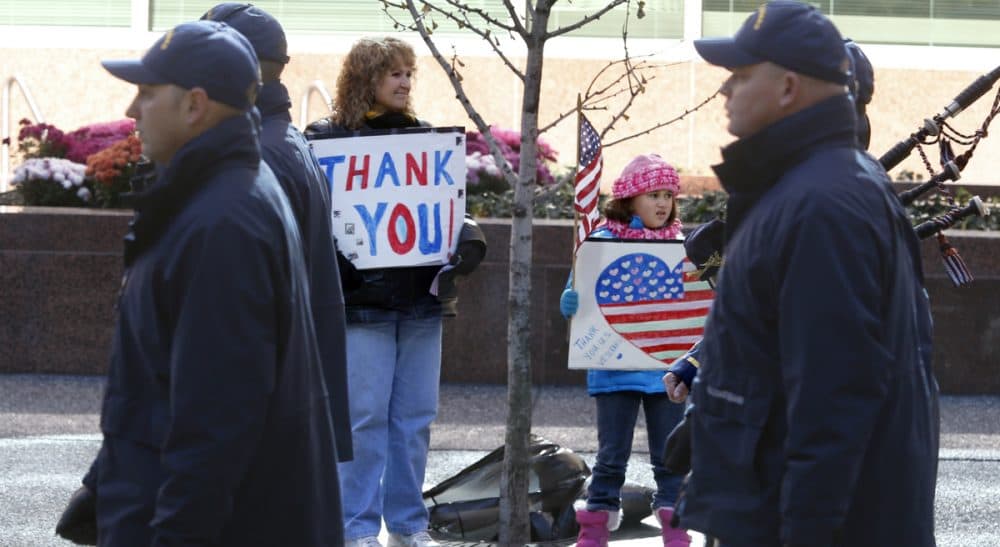Advertisement
A Call For A National Strategy On Veterans

Veterans Day in Britain is a solemn occasion. At the 11th hour on the 11th day of the 11th month (the moment of Armistice for World War I) there is silence for two minutes as the entire nation stops to pay tribute to those who lost their lives serving the British Commonwealth. The queen places a wreath on the Cenotaph. Old men and young people alike wear red poppies on their lapels. The day, also called Remembrance Day, is somber, observed by quiet national ceremonies across most of Europe and the world.
In the United States we lack this national moment of coming together. There are some parades and commemorations, but mostly the day is famous for sales — a kind of an early black Friday. As one big eCommerce website puts it “Whether you’re looking for holiday decorations, gifts, or just a little something for yourself, Veterans Day weekend is a great time to shop, as almost every store is having a sale!”.
Despite much effort, money and goodwill, the U.S. has no serious strategy for tackling the full range of challenges that veterans and their families are facing.
This attitude is not in tune with America. Polls repeatedly show that the public is worried about the violence in the Middle East and is wary about getting dragged back into war. There is a widespread desire to honor the troops. But somehow, collectively, we are not drawing together in solidarity with our 21 million living veterans.
Even though the U.S. has been at war continuously since 2001, there has been little — if any — shared sacrifice in recent years. Only a tiny fraction of the population has been directly involved in the fighting. More importantly, we haven’t actually paid for the war in cash — instead we have borrowed the money and put it on the national credit card (i.e., the national debt). So even though the United States has spent trillions of dollars in Iraq and Afghanistan, today’s taxpayers haven’t had to shoulder the burden by paying a war tax or buying war bonds or tightening our belts in any way. In fact, taxes were actually cut twice during the war years and hefty tax breaks were given to the wealthiest in our society — those who seldom serve in the military. This has led to a highly uneven distribution of the burden of war across the U.S. population.
Meanwhile, returning veterans have been struggling. More than two and a half million young men and women have been deployed to the Iraq and Afghanistan conflicts. Many have served two or three tours of duty; one-third of them are returning to rural communities around the nation where there are fewer medical facilities, jobs and opportunities. Half of these newly-returned service members are entitled to receive lifetime disability compensation. One of the immediate consequences is that the Department of Veterans Affairs is overwhelmed trying to process millions of disability claims and get everyone their medical appointments in a timely fashion. A bigger, longer-term problem is that the country has not prepared to pay for these benefits over the lifetime of the veterans — which will cost more than $1 trillion dollars. These annual price tags will rise over the next decades, if history is a guide. The disability costs for World War I did not peak until 1969, and those for World War II did not crest until 1986. The cost of caring for Vietnam veterans is growing every day.
More fundamentally, some veterans are falling through the cracks. Last year, more than 8,000 veterans killed themselves — more than all the fatalities in Iraq and Afghanistan combined. Studies show that veterans are at higher risk for suicide if they feel a “lack of belonging,” and that veterans with higher levels of social support were less likely to attempt suicide. The Iraq and Afghanistan Veterans of America recently published a shocking survey revealing that 31 percent of recent veterans had thought of suicide; 40 percent knew someone who had killed themselves, and 47 percent knew someone who had attempted to. Despite much effort, setting up hotlines and suicide prevention programs — the military and the VA have not been able to reverse this trend.
Veterans are facing challenges across the board — from finding meaningful employment and reintegrating into families and communities to translating their military skills into civilian ones and learning to enjoy life again. Female veterans, who now comprise 10 percent of the all volunteer force, have encountered additional difficulties, leading to higher rates of divorce, depression and unemployment. National guards, reservists and others who were older during their deployments have faced substantial disruption to their careers, with high unemployment and housing problems. Surveys show that young veterans are especially dismayed at the seeming futility of their efforts in Iraq and Afghanistan, as the region continues to threaten to come apart.
The question is whether we can expect the federal government to fix all the problems by itself.
The question is whether we can expect the federal government to fix all the problems by itself. The U.S. has already tripled the budget for the U.S. Department of Veterans Affairs, quadrupled the budget for the Department of Defense medical system and added nearly 50 percent more staff to the veterans department. It has set up suicide hotlines and substance abuse programs. It has fast-tracked the claims process and launched multi-billion dollar efforts to improve IT systems. It has made it easier for veterans suffering the after-effects of Gulf War syndrome or exposure to Agent Orange to claim compensation. But how much is reasonable for the government to do? The sense of shared national burden is still missing.
Despite much effort, money and goodwill, the U.S. has no serious strategy for tackling the full range of challenges that veterans and their families are facing. We urgently need a national strategy. The Institute of Veterans and Military Families has proposed this idea — but it would take action by Congress and the president to make it happen. Rather than simply hoping things work out and then throwing money at problems after they surface, we need to think through in detail how to support all of America’s veterans, including ways to finance these endeavors on a sustainable basis. If there’s one thing that should unite the newly-elected Congress, this has got to be it.
Linda J. Bilmes is the co-author of “The Three Trillion Dollar War: The True Cost of the Iraq Conflict.” She serves on the Board of Directors of the Institute for Veterans and Military Families and the US Department of Labor Advisory Board on Veterans Employment and Opportunity. She is the daughter of a World War II army veteran.
Related:
